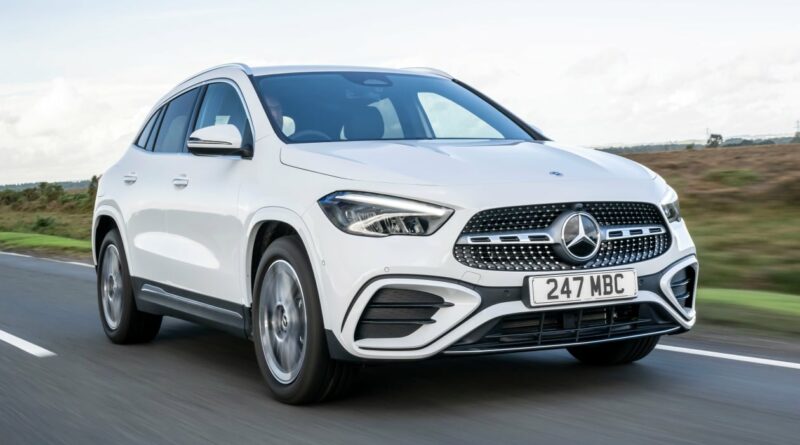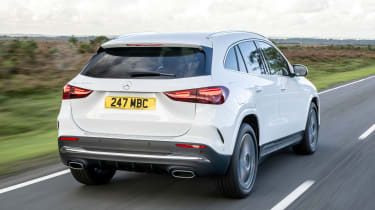New Mercedes GLA 2023 facelift review
The Mercedes GLA has been updated, but the plug-in hybrid GLA 250 e model is hard to recommend at this price point
3.5 out of 5
How we review carsBuy used for less at Buyacar
Verdict
A nip here and a tuck there haven’t transformed the GLA’s personality, but the changes, though small, have all added something positive. The new infotainment system is one of the best in its class, while the improved PHEV system will make the GLA 250 e more appealing to company car users. However, for everyone else, the GLA 250 e sits in a difficult price point with key rivals just below it and the all-electric EQA sitting just above.
We’re big fans of the Mercedes GLA. In fact, we liked it so much that we named it our Compact Premium SUV of the Year three years running.
Now, Mercedes has tried to improve the formula with a newly revised model. So what has changed, and in the face of new key rivals like the Alfa Romeo Tonale and the latest BMW X1, is it enough to lift it back to the top of the class?
From the outside, it’s hard to see what exactly has changed. Up front, base models get a subtly reprofiled front grille (AMG Line cars get a near-identical item to before, though) which is placed above a tweaked bumper whose fake air vents to each side have been subtly reshaped. Save for some revised graphics for the LED tail lights, the back end remains largely the same as before. There’s also an eye-catching new ‘Spectral Blue’ paint finish to choose from, and new wheel designs that range from 17 to 20 inches in diameter.
More reviews
Car group tests
- Mercedes GLA vs Volvo XC40
- Mercedes GLA review
- New Mercedes GLA 250 e 2021 review
- New Mercedes-AMG GLA 35 2020 review
- New Mercedes GLA 220d diesel 2020 review
- New Mercedes GLA 2020 review
- Used Mercedes GLA (Mk2, 2020-date) review
- Used Mercedes GLA (Mk1, 2013-2020) review
In-depth reviews
Road tests
Used car tests
Inside, the cabin upgrades are also on the subtle side, with the most significant change coming in the form of the brand’s latest MBUX infotainment system. The 10.25-inch touchscreen is sharper and faster than the previous unit, and the menus remain logical to work out. New menus for the powertrain graphically display parameters like power and torque in real time, plus historical fuel consumption can also be recalled. Each page presents its data clearly while looking great. The slightly fiddly touchpad has been ditched – leaving a slightly pointless rubberised patch in its place on the centre console, so now it’s touchscreen only.
In the back, the GLA remains impressively spacious, beating the BMW X1 by some margin when it comes to head- and knee room. It even runs the cavernous Alfa Romeo Tonale very close, despite measuring up 92mm shorter on the outside than its Italian rival. A 445-litre boot is respectable, too.
Under the skin, the GLA’s powertrain roster will offer something for everyone, with petrol, diesel, and PHEV powertrains to choose from – and there’s still the fully electric EQA in its various forms, too. Of those, the diesels are carried over largely unchanged, but the 48-volt hybrid system added to the petrols provides a 14bhp boost to reduce load on the four-cylinder unit, therefore increasing fuel efficiency.
We’re driving the GLA 250 e PHEV here, and that system has received a couple of tweaks, too. As before, the combustion element comes in the form of a 161bhp 1.3-litre four-cylinder petrol, but the electric motor it is attached to makes 107bhp – 7bhp up on the previous model. Its peak torque remains at 300Nm.
For private buyers, the petrol GLA 200 will make plenty of sense. The hybrid system is keen to cut out when coasting towards a junction, and the engine fires up smoothly when more power is needed. Performance, once again, is fine rather than exciting, but we were averaging an indicated 43mpg on a route that consisted of plenty of the sort of twisty B-roads that aren’t the most flattering for fuel efficiency.
When its closest rivals are the super-firm Alfa Romeo Tonale and the BMW X1, then the GLA’s ride doesn’t seem so harsh. The PHEV model is a little more settled over larger bumps than its traditional combustion stablemates, but the Audi Q3 is a much smoother companion over rough roads. The Mercedes isn’t particularly fun through the turns, but it’s very secure, stable and predictable. Road noise is a little high compared to the competition, though.
There is another, larger achilles heel for the GLA 250 e to overcome, though, and that’s price. In AMG Line Executive trim, the PHEV range kicks off from £45,210, while this middling AMG Line Premium trim costs £46,820. A BMW X1 xDrive25e has 27bhp more, and can travel even further in fully electric mode, yet starts at £41,980. The Tonale has 276bhp and kicks off from £44,595.
Equipment levels are fairly generous, though, with the 10.25-inch touchscreen, 19-inch alloy wheels, LED headlights, part artificial leather/suede upholstery and wireless smartphone charging.
However, within its own stable, Mercedes offers the all-electric EQA 250, which offers similar performance and tiny company car tax rates in comparison, yet cost-wise is only a small step up, starting at £49,750. Those who buy privately will be able to save with the GLA 200 mild hybrid petrol, which like-for-like costs £4,105 less than the PHEV.
| Model: | Mercedes GLA 250 e AMG Line Premium |
| Price: | £46,820 |
| Engine: | 1.3-litre 4cyl turbo, 1x e-motor, 16kWh battery |
| Transmission: | 8-speed auto, front-wheel drive |
| Power: | 215bhp |
| 0-62mph: | 7.9 seconds |
| Top speed: | 130mph |
| Economy: | 218.8-256.8mpg |
| CO2: | 26g/km |
| Size (l/W/H): | 4,436/1,849/1,605 |
| On sale: | Now |
Source: Read Full Article








